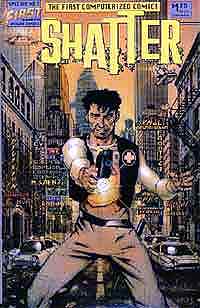Computer magazines
by Tony Quinn
Computer magazines in Britain are listed here. The emphasis is on consumer titles – several of which I ran in the 1980s – rather than trade magazines for people working in the industry, such as Computer Weekly and Computing, which have been around much longer.
With the advent of mass-market home microcomputers, particularly the Sinclairs and BBC/Acorn micros, in the early 1980s, the range of titles was diverse. A June 1984 survey in Campaign identified 46 titles from 15 publishers. The leading companies were Argus, with 12 magazines, and VNU with five. Other publishers were East Midlands Allied Press (Emap), ECC and Sunshine. There were two main types of magazines: user specific and umbrella. Examples in the first category were Emap's Sinclair User and BBC/Redwood's Acorn User. The best seller was the umbrella title Your Computer published by IPC's Electrical Electronic Press, with a circulation of 122,642 copies.
The next boom was spurred by Amstrad turning the IBM PC into a mass market, for both business and the home, with its cheap clones. By 1990, the publishing directory Brad listed more than 160 magazines as business titles and 30 in its consumer section. The biggest-selling consumer titles were:
- Emap's Computer and Video Games at 92,060;
- Your Sinclair, which Future had just bought from Dennis Publishing, at 78,393.
- Emap's Sinclair User at 76,055.
Other publishers were Interactive (Amiga Computing, Atari ST User, Amiga Action and ST Action) and Newsfield (Crash, The Games Machine and Zzap 64). Although these sales figures look good, the writing was on the wall for the user magazines. All these titles had lost 10%-15% of their sales in a year, with the rise of the PC and dedicated games consoles such as the Nintendo. As an example, Acorn User's ABC fell from more than 57,000 in 1986 to 18,108 for January-June 1993.
IF YOU know about other titles, contributions on the many titles not yet covered – remember Dragon User? Zzap 64? – would be welcome.
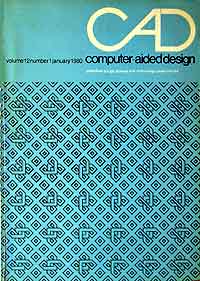 CAD: a bimonthly academic journal. The cover of the issue here (January
1980) showed a computer-aided picture by Paul
Brown of the Slade School of Fine Art (Brown became a vising professor at Sussex university
developing a robot to demonstrate creative drawing behaviour) |
Computer-Aided DesignIPC Science and Technlogy Press/Elsevier. April 1978-Before there were computer magazines, there were academic journals, such as this one, with an annual subscription for six issues a year of £50 in the UK. The managing editor in 1980 was Alan Pipes, who went on to edit CADCAM International at Emap and write books on art and design. The sub-editor, Tony Quinn, later launched Acorn User and other titles at BBC/Redwood. |
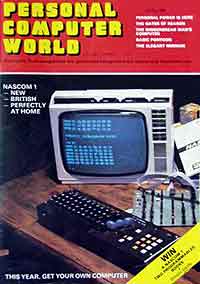 Personal Computer World: the UK's first magazine for microcomputer enthusiasts
– in the days when you built your own |
Personal Computer WorldVNU. April 1978- |
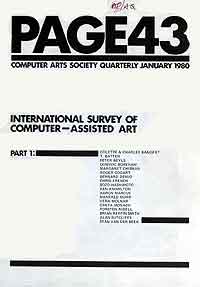 Page: for the Computer Arts Society |
PageComputer Arts Society. January 1980-The Computer Arts Society is a specialist group of the British Computer Society founded in 1968. The editor of the quarterly Page in 1980 was Dominic Boreham. The secretary and treasury of the group were, respectively, John Lansdown and George Mallen. These two pioneers were later to develop the computer-animated graphic for Channel 4. Page on CAS website Back issues from 1969 |
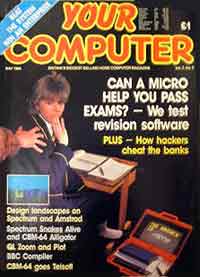 Your Computer, the May 1985 cover |
Your Computer [closed]IPC Electrical Electronic Press. 1981-?In its December 1982 issue, Your Computer under editor Toby Wolpe invented the cover disc. At at time, computer discs were unknown outside the world of mainframes, so micro owners typed listings in by hand. They then saved them as sounds on cassettes. With Your Computer's plastic disc, played on a standard record player at 33.3 rpm, computer programs could be input as binary sounds. The disc held games for the Sinclair ZX81. In 1984, The Your Computer was the bestselling computer titles, with a circulation of 122,642 copies. It was always a stapled title, but lost out to Personal Computer World, which stressed its business credentials, was perfect-bound and felt classier. IPC profile |
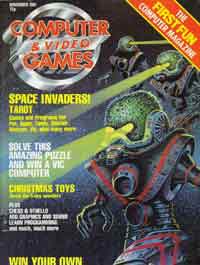 Computer & Video Games: November 1981 launch issue cover of the 'first fun computer magazine' |
Computer & Video Games [closed]Emap/Dennis/Future. November 1981-August 2004Computer & Video Games was launched by Emap and claimed to be the world’s first games magazine. It was then sold on to Dennis and finally closed by Future in 2004, though website lives on. www.computerandvideogames.com |
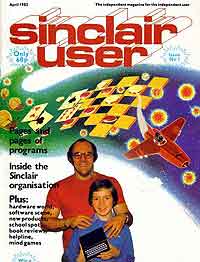 Sinclair User: April 1982 for owners of the world's first mass market home computer. Sinclair machines sold in their millions |
Sinclair User [closed]Emap. April 1982-?Emap was one of the first companies to get into home computer in a big way. Its Business and Computer Publications division launched home computer titles such as ACE, Commodore User, Computer & Video Games, The One and Sinclair User. As well as these its business titles included Educational Computing, CADCAM International and PC User. |
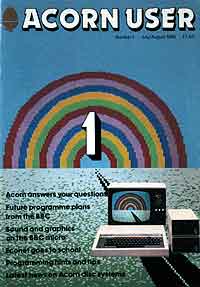 Acorn User was one of the longest-lasting machine-specific titles that thrived in the 1980s. It eventually closed in 2005 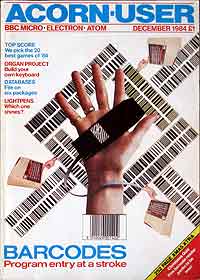 In December 1984, Acorn User launched a bar code reader and published its programs in bar codes so readers did not have to type them in. About 2000 of the devices were sold, mainly to schools 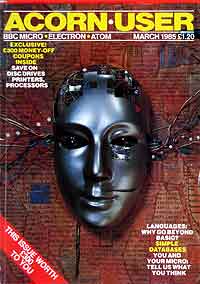 The March 1985 cover based on a model by Russell Mills 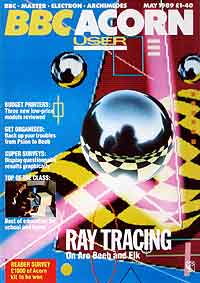 Computer graphics was always a strong point of Acorn User. The May 1989 issue focused on ray tracing |
Acorn User[closed]July 1982- spring 2005. Addison-Wesley/Redwood/BBC/Europress/Quest Design and Publishing.Successful title for BBC Micro users that was set up maths publisher Jane Fransella at Addison-Wesley with Acorn Computers. The BBC branded the computer, which was made by Acorn in Cambridge, as part of its Computer Literacy Programme to educate people about computers. At the same time, the government gave computers to every school in Britain (they could choose from a BBC Micro, Sinclair Spectrum or Research machines Z80). From the outset, Acorn User used electronic mail (Dialcom). It changed hands a year after its launch to the founders of contract publisher Redwood Publishing (Michael Potter, former publisher of Campaign, Christopher Ward, a former editor of the Daily Express and a non-executuve director of Acorn, and Christopher Curry, one of the founders of Acorn). The company was later taken over by the BBC. Redwood installed an large network of BBC Micros in 1984 to replace its typewriters for journalists. (BBC titles such as Good Food and Gardeners' World used the same technology until it was superseded by Quark XPress running on Apple Macintoshes.) Acorn User had a circulation figure of more than 57,000 in 1986. In January 1989, Redwood restructured to prepare for the launch of BBC titles such as Good Food. Geoff Bains became editor of Acorn User and Seamus Geoghegan becames publisher of Acorn User and Educational Computing. In 1993, Redwood sold Educational Computing to Training Information Network and Acorn User (its ABC figure was 18,108) to Micro User and Acorn Computing publisher Europress in Manchester. Although Europress said there was a future for the all the titles, both of these were merged in to Acorn User. The magazine's life was extended because Acorn spun out chipmaker ARM, whose reduced instruction set (RISC) chips power many of the world's mobile phones and devices. An interesting diversion is that AU editor Tony Quinn appointed two part-time assistant editors when the title moved to Redwood: Bruce Smith and Alex van Someren. As a sideline, this trio later set up a computer book publishing company, Victory. Another AU contributor was Dave Atherton, then software editor at BBC Enterprises. Victory later sold out to Dave Atherton and Bruce Smith, who formed Dabs Press (from their initials) – which later became Dabs.com and was bought by BT. Bruce has gone on to become a prolific and best-selling book author. Another contributor was Graham Bartram, who now runs Flags.net. Alex van Someren with his brother Nico founded nCipher, a company that developed encryption systems using Arm processors. Alex married the Acorn User reporter Carol Atack, who is now a Cambridge classicist Contributors to Acorn User included the late Mike Milne, who went
on to set up the computer graphics arm of Framestore
and create the Walking With Dinosaurs BBC TV series; David
Deutsch, quantum computing pioneer at Oxford University; Malcolm
Banthorpe, BBC videotape editor who won two Bafta
awards for his work, including one for the computer graphics on
The Life and Loves of a She Devil; and Susan Stepney,
now professor of computer science at York university, who published
some of the earliest UK articles
on fractals in Acorn User. Simon Dally, the competition editor, was a book publisher
(The Henry Root Letters and Rupert Cornwall's The Hacker's Handbook were two titles
he championed) who set up the world's first commercial online MUD
– Multi User Dungeon – with BT in 1985 (he told Tony Quinn he found the
minicomputer to run it on in a skip). MUD was based on the program
run by Richard Bartle and Roy Trubshaw for four years on the University
of Essex mainframe. |
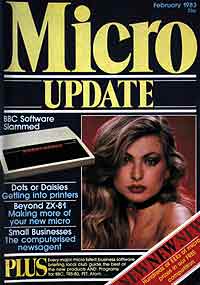 Micro Update first issue. It covered all the machine formats and put women on its covers to appeal to male readers |
Micro Update [closed]February 1983. Argus, London. 75p; 124pp. Editor: Paul LiptrotA feature on the British computer the Oric, reveals it was named after Orac, from the Blakes Seven TV series. |
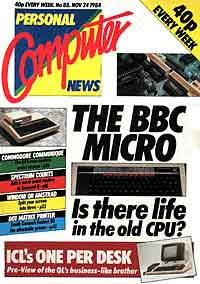 Personal Computer News |
Personal Computer News [closed]18 March 1983-?. VNUFelix Dennis was the publisher of this weekly. Cyndy Miles was the editor. |
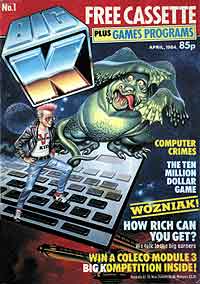 Big K launch cover. Later issues featured a cartoon series – Shatter
– drawn on an Apple Macintosh, below 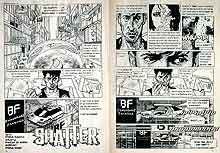 |
Big K [closed]IPC Magazines, London. April 1984. 85p. 108pp. Ed: Tony Tyler; pub dir: John PurdieGames title with free cassette. Based on readers typing in games listings. First issue had programs for the Commodore Vic20 and 64, Oric, BBC/Acorn and Sinclair Spectrum. In issue 12 (March 1985) it launched a comic strip – Shatter –
drawn on an Apple Macintosh, which claimed to be a world first (by
Mike Saenz, Peter B. Gillis and Mike Gold). A one-off comic
Shatter was published in the US dated June 1985 by First
Comics (below) |
MicroMath [closed]Spring 1985Journal of the Association of Teachers of Maths |
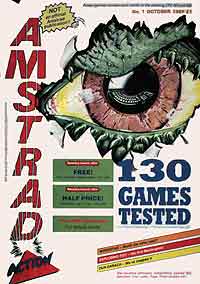 Amstrad Action first issue – a keyboard is reflected in the monster's eye
|
Amstrad Action [closed]October 1985. Future, Somerton, Somerset. £1; 100pp. Ed: Peter Connor. Pub: Chris AndersonAimed at Amstrad CPC games market. Chris Anderson had been editor of Personal Computer Games and Zzap! 64 in London. He moved to Somerton and founded Future with Amstrad Action. The magazine focused on games reviews and playing them rather than typing in.listings, which was a core element of the user magazines. The top of the front cover reads: 'Power-packed reviews each month on the amazing CPC 464 and 664.' To the left of the vertical masthead is another selling line: 'The mouldbreaking magazine from Future Publishing.' The editorial describes how the title was written on Amstrads and sent by modem to the typesetters, who returned typeset copy for the editors to paste up. Anderson was known as 'Ayatullah' by the staff and named newspaper tycoons Robert Maxwell and Rupert Murdoch as his heroes. Future profile |
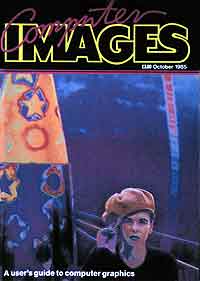 Computer Images – launch issue above and as a quarterly a year later, below 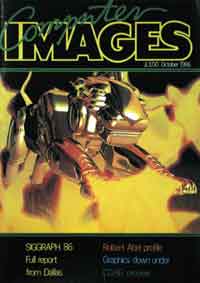 |
Computer Images [closed]October 1985. Emap McLaren, Croydon. £3. 56pp.Ed: Bob Swain. Pub: Michael J. Eades Supplement sent to readers of Audio Visual and Television and Video Production. By October a year later it was a quarterly. |
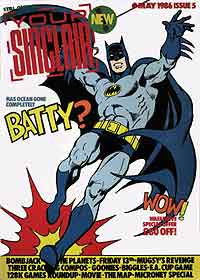 Your Sinclair: issue 5 from May 1986 |
Your Sinclair [closed]Dennis/Future. January 1986-? |
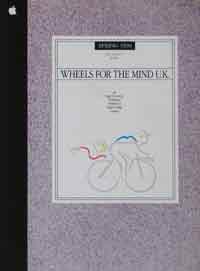 Wheels for the Mind: a magazine produced on Apple kit in spring 1990 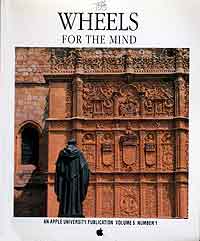 Wheels for the Mind: relaunched in September 1990 |
Wheels for the Mind [closed]Apple Computer UK/King's College London. 1986-?The advent of the Apple Macintosh and Pagemaker software made desktop typesetting and design possible. Wheels was published by Apple for members of the Apple University Consortium. The editor was David Riddle at King's College London and it was produced by Robert Smyth at QMW University of London. In 1990, Apple brought in specialist publishing expertise in the form of project manager Linda Dhondy, who relaunched the title with a design by Sian Lewis, who had designed Apple Business. |
Putting Your Amstrad to Work [closed]September/October 1986. Focus InvestmentsAimed at users of Amstrad wordprocessing systems with bundled printer |
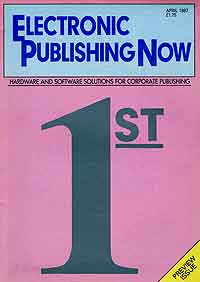 |
Electronic Publishing Now [closed]April 1987Aimed at booming DTP market, which was still dominated by the Apple Macintosh but with PCs moving in. The editor was Bruce Smith (ex-Acorn User deputy). By July 1987 there were four titles devoted to the topic: Desktop Publishing Today, DTP, The Desktop Publisher and Electronic Publishing Now. |
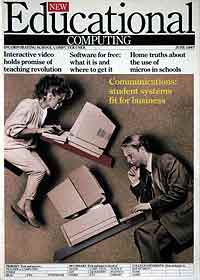 Educational Computing was born out of a merger of Redwood's School
Computer User and Emap's Educational Computing tabloid newspaper |
Educational Computing [closed]Redwood/BBC/ITT. Controlled circulation/subscription.October 1987-2004?Acorn User had a big readership in schools that it wanted to build on and schools were crying out for advice on using the computers were being given. The problem, for a new, small, publisher was the cost of distribution. So Acorn User's editor, Tony Quinn and publisher, Simon Goode, approached computer educational adviser Mike Bostock for guidance on a deal with local education authorities (LEAs): they would take free magazines in bulk and distribute them to schools. Redwood would make its money from advertising. Most of the LEAs signed up for the deal. It was a unique idea and from it a quarterly called School Computer User was launched. At about the same time, Emap had decided to close its subscription-based monthly tabloid format Educational Computing (the publisher of which was Tom Moloney, who became chief executive of Emap in 2005). This had almost 10,000 subscriptions, so Redwood bought the title. Redwood combined School Computer User's distribution model and editorial strategy with the name Educational Computing. The magazine's name was later expanded to Educational Computing and Technology. In 1993, Redwood sold Educational Computing to Training Information Network ITT Publications. |
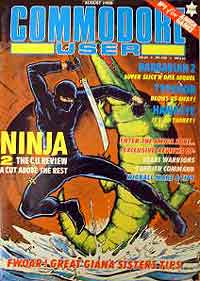 |
Commodore User [closed]Emap. August 1988-? |
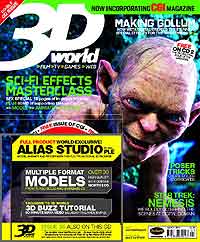 3D World in March 2003 had just taken over CGI magazine |
3D WorldFuture |



